How to Use a 12-Cup Moka Pot
A 12-cup moka pot is great for making strong, espresso-like coffee for several people. It's a big step up from single-cup brewers. You can make enough for your family or a few friends at once.
But using a big moka pot can be tricky. The biggest confusion is the size. A "12-cup" moka pot won't give you 12 big mugs of coffee. This guide will show you how much it really makes and how to use it right.
What a 12-Cup Moka Pot Is
Before you buy a moka pot, you need to know about its size. The way they are labeled can be confusing. This can lead to you buying the wrong pot for your needs.
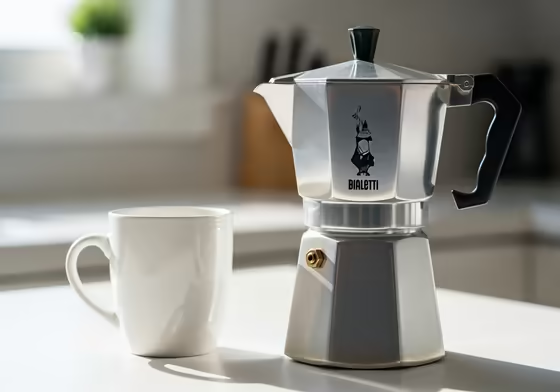
How Much Coffee Does It Make?
Moka pot "cups" are not the same as a standard 8-ounce measuring cup. They are based on small Italian espresso cups, called a tazza . These only hold about 1.5 to 2 ounces of coffee.
Here's what that means for a 12-cup moka pot:
- Total Water Volume: The bottom part holds about 26 ounces (775 ml) of water. You should fill it right up to the safety valve.
- Final Coffee Yield: You won't get 26 ounces of coffee out of it. The grounds soak up some water, so you end up with about 20 ounces (600 ml).
- Physical Size: These pots are pretty big. A classic 12-cup Bialetti is over 11 inches tall and weighs almost 3 pounds.
Is the 12-Cup the Biggest Moka Pot?
The 12-cup pot is big, but it’s not the biggest one you can buy. Bialetti also makes an 18-cup moka pot. The 18-cup model is for very large groups of five or more people.
But the 18-cup pot is hard to use correctly. It takes a long time to heat, which often makes the coffee taste bitter. That's why the 12-cup pot is the biggest size most people find useful for good coffee at home.
How to Find Your Moka Pot's Size
If you have a moka pot and don't know its size, there are two easy ways to figure it out.
- Measure the water. Fill the bottom part with water up to the little safety valve. Then pour that water into a measuring cup to see how much it holds.
- Measure the pot. Use a ruler to check its height and the width of the base. You can compare these numbers to charts from the company that made it.
Table 1: Moka Pot Sizing and Yield Guide
| Pot Size (Cups) | Approx. Water Capacity (ml) | Approx. Coffee Dose (g) | Approx. Final Yield (ml) | Approx. Final Yield (fl oz) | Best For (Servings) |
|---|---|---|---|---|---|
| 1-Cup | 60 ml | 6 g | ~50 ml | ~1.7 oz | 1 espresso shot |
| 3-Cup | 130-200 ml | 15-20 g | ~100-150 ml | ~3.4-5 oz | 1 person, 1 small mug |
| 6-Cup | 250-300 ml | 27-30 g | ~220-250 ml | ~7.5-8.5 oz | 2 people, or 1 large mug |
| 9-Cup | 410-550 ml | 45-55 g | ~350-450 ml | ~12-15 oz | 3-4 people (small cups) |
| 12-Cup | 595-775 ml | 60-77 g | ~595-600 ml | ~20 oz | 4-5 people (small cups or lattes) |
| 18-Cup | 800-810 ml | ~80-90 g | ~750-800 ml | ~25-27 oz | 5+ people (large groups) |
Data compiled from various sources.
Which 12-Cup Moka Pot to Buy
When you buy a 12-cup moka pot, think about two main things. You need to consider the material it's made from and what kind of stove you have.
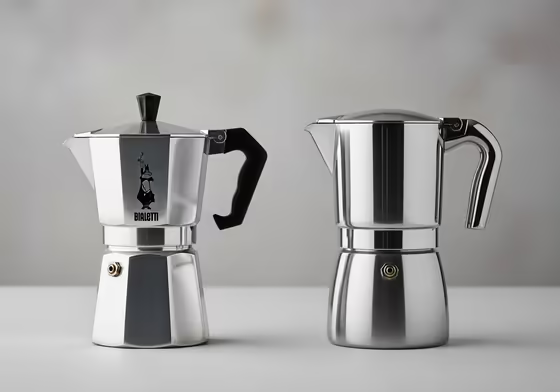
The Classic Bialetti (Aluminum)
This is usually the classic Bialetti Moka Express. It’s the original design from 1933 and is still very popular.
- Material: It's made of aluminum with a plastic handle.
- Pros: It’s a classic made in Italy and known for being tough and affordable. Some people think the aluminum gets "seasoned" over time and makes the coffee taste better. It also has a safety valve that's easy to clean.
- Cons: Since it's aluminum, you can't use it on an induction stove. It also has to be washed by hand. Some people have said the larger 12-cup models can have issues where the top and bottom don't fit perfectly.
Even though some coffee experts think it's old-fashioned, it’s still a simple way to make strong coffee. It works well for making a lot of coffee at once.
Stainless Steel 12-Cup Moka Pots
It's really hard to find a 12-cup moka pot made of stainless steel. The big companies just don't make them in that size.
Here are the main differences between aluminum and stainless steel.
- Aluminum: Aluminum heats up fast and evenly. It's also lighter and cheaper. But, you can't put it in the dishwasher or use it on an induction stove.
- Stainless Steel: Stainless steel is stronger and won't rust. You can usually put it in the dishwasher, and it works on all stovetops, including induction. The downside is that it's more expensive.
The biggest stainless steel moka pots you can usually find are 10-cup models. Bialetti's Venus and Musa are popular examples. This means you have to make a choice.
- Prioritize capacity and buy the 12-cup aluminum Moka Express.
- Prioritize material (for induction or durability) and downsize to a 10-cup stainless steel model.
Using a Moka Pot on an Induction Stove
An aluminum moka pot won't work on an induction stove. Induction cooking uses magnets to create heat, and aluminum isn't magnetic. You have three ways to solve this problem.
- Get a stainless steel pot. A 10-cup model like the Bialetti Venus will work, but you'll lose some capacity.
- Buy a special "Moka Induction" pot. Bialetti makes these with a steel bottom and an aluminum top. They work, but they are usually smaller, and some people find them tricky to use.
- Use an induction adapter plate. This is a metal disc you put on the stove, and then you place your aluminum pot on top of it.
If you need the 12-cup size and have an induction stove, here's the best plan. Buy the 12-cup aluminum Moka Express and an induction adapter plate. This lets you use the big pot you want on your stove.
Where to Buy a 12-Cup Moka Pot
While smaller moka pots are easy to find, the 12-cup model can be harder to buy in stores.
-
Online (Best Choice)
- Kitchen stores like Williams-Sonoma or Sur La Table often have them.
- Amazon has the biggest selection of different brands.
- Websites that import Italian goods are also a good place to look.
-
In Stores (Call Ahead)
- Big stores like Target or Walmart might have them. Check their websites first to see if a store near you has one in stock.
- The best way to buy one "nearby" is to check online for in-store pickup. If not, just order it online.
How Much Coffee to Use
You don't get to choose how much coffee to use in a moka pot. The pot's design decides the amount for you.

Should I Use a 'Golden Ratio'?
Many coffee brewing methods, like pour-over or French press, use a "golden ratio" of coffee to water. This is usually around 1 part coffee to 18 parts water.
You should not use this ratio for a moka pot. The pot is designed to work with a specific amount of coffee and water. Trying to use less coffee won't work and will mess up the brewing.
The Right Moka Pot Ratio
A moka pot uses a much stronger ratio, closer to 1 part coffee for every 7 to 10 parts of water. For a 12-cup pot, the amount can vary a little.
Some guides say to use about 77 grams of coffee for 775 ml of water. But many people find they use closer to 60 grams. This is because darker roasts are less dense, so 60 grams of a dark roast might fill the basket.
So, a 12-cup filter basket holds between 60 and 77 grams of coffee. The exact amount depends on how dark your coffee beans are roasted.
The Most Important Rule for Adding Coffee
Here is the most important rule for brewing with a moka pot. You must fill the filter basket completely, but do not pack the grounds down. Here's how to do it right.
- Fill the basket with coffee grounds. It's okay if it mounds up a little bit.
- Tap the side of the filter to help the grounds settle.
- Use your finger to make the top flat. Do not press down on the grounds at all.
People call it a "stovetop espresso maker," but it doesn't work like a real espresso machine.
- Taste: Tamping the coffee blocks the water flow. This will make your coffee taste burnt and bitter.
- Safety: It's also dangerous. Tamping creates too much pressure inside the pot. If the safety valve is clogged, the pot could burst.
Getting Your Coffee Ready
Once your pot is ready, you just need to choose the right coffee beans and grind size.
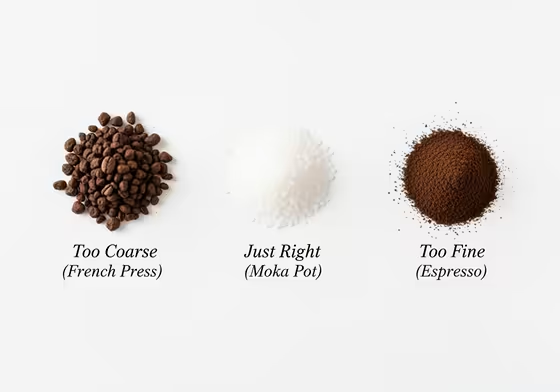
What Grind Size to Use
The right grind is medium-fine. It should feel like table salt. It's finer than drip coffee but coarser than powder-like espresso grind.
-
Grind size is really important.
- If the grind is too coarse, the water will run through too fast. Your coffee will taste weak and sour.
- If the grind is too fine, it can clog the filter. This makes the coffee bitter and can create a dangerous amount of pressure.
With a big 12-cup moka pot, it's better to make your grind a little bit coarser. This is because larger pots take longer to brew. A coarser grind helps prevent the coffee from tasting bitter.
What Kind of Roast is Best?
A moka pot works best with medium or dark roast coffees. The hot, pressurized water really brings out their deep flavors.
- Medium roasts will give you a smooth and rich cup of coffee.
- Dark roasts create that classic, bold, and smoky Italian coffee taste.
- Light roasts are not a good choice for moka pots. The brewing method can make them taste very sour. You'll lose the nice, subtle flavors that light roasts are known for.
Which Coffee Beans Should I Buy?
You have two great options when choosing coffee for your moka pot.
-
Buy Pre-Ground Italian Coffee.
For an easy and authentic taste, use coffee from brands like Lavazza or Illy. This coffee is already ground perfectly for a moka pot. Using these brands is the best way to get that classic flavor.
- Good brands to look for are Lavazza, Illy, Cafe Bustelo, and Cafe La Llave.
-
Grind Your Own Beans.
If you grind your own, pick beans that are full-bodied and not too acidic.
- Beans from Brazil, Sumatra, or Colombia are great choices.
- For a stronger taste, look for a blend that has some Robusta beans in it.
Common Problems and How to Fix Them
To get great coffee from a 12-cup moka pot, you need to control the heat and brewing time.
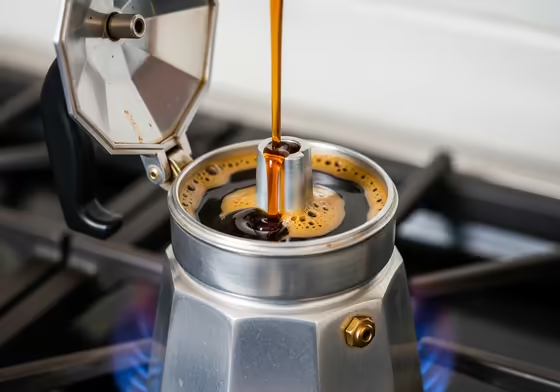
Why Does My Coffee Taste Bitter?
Bitter coffee is the most common problem with moka pots. It happens when the water is too hot or is in contact with the coffee for too long. Here are the four main causes and how to fix them.
-
Cause: You Used Cold Water. Putting cold water in the pot means it sits on the hot stove for a long time. This can scorch the coffee grounds before the brewing even starts.
- Fix: Always start with hot or boiling water in the bottom part of the pot. This makes the brewing process much faster.
-
Cause: Your Heat is Too High. High heat forces water through the coffee too fast, which burns it. It also makes the pot sputter and spray coffee everywhere.
- Fix: Use low to medium heat. The coffee should flow out in a slow, steady stream.
-
Cause: You Brewed for Too Long. When you hear a gurgling or sputtering sound, the good coffee is done. What comes out after that is just bitter steam.
- Fix: The sputtering sound means you need to stop. Take the pot off the heat right away. Run the bottom of the pot under cold water to stop the brewing instantly.
-
Cause: Your Grind is Too Fine. A grind that is like powder will clog the filter and make the coffee taste bitter.
- Fix: Make sure your grind looks like table salt. For a 12-cup pot, it's even better if it's a little coarser.
How to Keep Your Moka Pot Safe
This almost never happens. A moka pot can't explode if you use it the right way and keep it clean. Follow these four rules to stay safe.
- NEVER TAMP THE COFFEE: This is the biggest mistake. Pushing down on the coffee grounds blocks water from getting through.
- NEVER OVERFILL THE WATER: Do not fill the water past the bottom of the safety valve. The valve needs space to release steam.
- CLEAN YOUR SAFETY VALVE: This valve releases pressure if it builds up too much. Make sure it isn't clogged with mineral buildup so it can move freely.
- USE THE RIGHT GRIND: If the coffee is ground too fine, it can clog the filter screen and block water.
A problem only happens if you make a mistake, like tamping the coffee, and also fail to clean the pot. If you don't tamp the grounds and you keep the valve clean, you'll be fine.
What Are the Downsides?
- It takes practice. You have to get the heat, grind, and timing right to avoid bitter coffee.
- You have to watch it. You can't just turn it on and walk away like a drip coffee machine.
- Aluminum pots must be washed by hand. You also need to clean and replace the rubber gasket sometimes.
- You can't make a small batch. A 12-cup pot must always be used to make 12 cups of coffee. You can't half-fill it.
Moka Pot vs. Other Brewers
Let's see how a moka pot compares to other coffee makers.
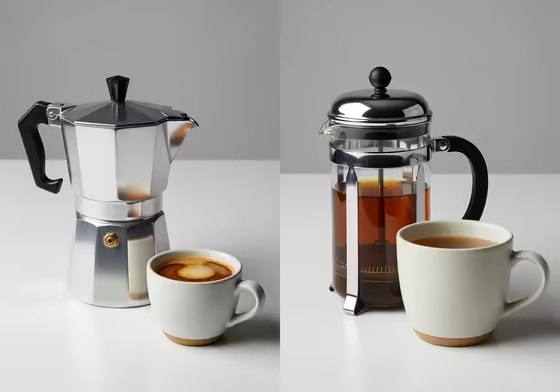
Moka Pot vs. French Press
These brewers are not better or worse, they just make very different coffee.
-
Moka Pot
- It brews under pressure and uses a medium-fine grind.
- The coffee is strong and intense, like espresso.
- It's best for making lattes or cappuccinos because the coffee is strong enough to mix with milk.
-
French Press
- It brews by steeping coffee in hot water and uses a coarse grind.
- The coffee is full-bodied and rich, with an oily texture.
- It's better for enjoying the subtle flavors of a specific coffee bean.
For a sharp, intense coffee, choose the Moka Pot. For a heavy, rich cup, choose the French Press.
What Size Moka Pot for 4 People?
You should get the 12-cup moka pot if you're making coffee for 4 people.
A 6-cup pot is perfect for one or two people. It's just not big enough to serve four.
A 12-cup pot makes about 20 ounces of coffee. This gives each of the 4 people a 5-ounce serving. This is great for small cups or for making lattes.
Other Moka Pot Sizes
- 6-Cup Moka Pot: The 6-cup is the most popular size. It's perfect for 1 or 2 people and is easier to use than the bigger pots.
- 18-Cup Moka Pot: The 18-cup is for big parties with 5 or more people. It is very hard to use without making the coffee taste bitter.
Since you can't make small batches in a big moka pot, many people own more than one. A good idea is to have a small 3-cup or 6-cup for yourself. Then you can use the 12-cup pot when you have company.